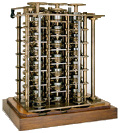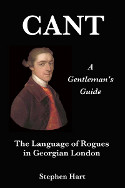18th Century Pharmacopeia
Two important pharmacopeia (books of medicinal recipes) in the 18th century are Thomas Fuller's Pharmacopeia Extemporanea, published in 1710 and the medicinal recipe section of William Buchan's Domestic Medicine in 1769. I have also added 11 recipes from the Reverend William Twigge's unpublished Notebook, dating to about 1715.
I have divided both into individual recipes with indexes (see below).
Database Search

To track down individual ingredients, I recommend using the Database search (e.g. search the body text for "snail"). Click on the name in the results list (e.g. Antimonal Ale) to see more details.
The Pharmacopeia Extemporanea
Thomas Fuller published his Pharmacopeia Extemporanea in English in 1710. It caused quite a stir by giving away medical recipes previously guarded jealously by doctors. He explains his motives in The Preface.
Fuller lists some 800 recipes, divided into the following categories:
- Ales
- Bags, Balsams, Boluses, Broths and Cakes
- Cataplasms and Caudles
- Decoctions
- Diets and Draughts
- Electuaries
- Eleosacchara, Elixirs, Emetics, Emulsions, Epithems, Errhines and Essences
- Expressions and Extracts
- Foments, Frontals and Fumes
- Gargles
- Glysters
- Honeys, Hydrogalas, Hydromels and Infusions
- Juices and Juleps
- Lambatives, Laudanums, Lavaments, Liniments, Litus, Lixivia and Lohochs
- Lotions, Lozenges and Masticatories
- Mixtures
- Nodules, Oils, Oxymels, Pastes and Pellets
- Pills
- Plaisters
- Possets and Potions
- Powders
- Ptisans, Quilts, Robs, Sudorificks, Spirits, Stones, Sugars, Suppositories and Syrups
- Tinctures and Tobaccos
- Unguents
- Vapours, Wafers, Waters, Wheys and Wines
Domestic Medicine
William Buchan published his Domestic Medicine in 1769. It was immensely successful, going through 19 editions and selling 80,000 copies in his lifetime. The full text of Domestic Medicine is available at this link.
In addition to his medical advice, Buchan lists 168 recipes for medicines. I have divided them up in the same manner as Fuller's Pharmacopeia Extemporanea. The recipes are taken from the 2nd edition published in 1785.
Buchan's recipes are divided into the following categories, explanations of which I have extracted into a single page of medicinal preparations
See the following index pages for links.
- Balsams, Boluses, Cataplasms, Clysters and Collyria (Eye-waters)
- Confections, Conserves, Decoctions, Draughts
- Electuaries, Emulsions, Extracts, Fomentations and Gargles
- Infusions, Juleps and Mixtures
- Ointments and Pills
- Plasters and Powders
- Simple and Spirituous Waters and Syrups
- Tinctures
- Vinegars, Wheys and Wines
The Reverend Twigge's Notebook
The Reverend William Twigge was the Archdeacon of Limerick from 1705 to 1726. He left behind a notebook of household recipes (probably compiled by his wife Diana and his daughter Jane between 1704 and 1715) which as well as the usual instructions for baking cakes and pickling onions contained 46 medicinal recipes. Eleven of these have been published online by Aideen Ireland in a paper entitled Medical remedies from 18th century Limerick. I have not yet been able to obtain the full list but I have included the recipes from Ireland's article in the database.The recipes are entitled:
- For the bloody flux
- A bath for the gravill
- The recept of the plurisy water
- To make the oyle for the rickets
- To make the snaile water for the consumsion or cough of the lungs
- A receipt to make surfeet water
- To heale a burn without a scarr
- For jaundice in children
- The ingredients of the purging ale
- A salve for old sores and ulcers
- An excellent medicine for a stitch
Units of Measurement
Many recipes use Apothecary units, some of which may be unfamiliar.
The smallest unit of weight is the grain, weighing 64.8 mg or 1/480 of a troy ounce. The equivalent unit of volume is the minim. Fuller uses the term drop which is roughly equivalent to 20 minims . The other main units are the scruple - 20 grains, and dram or drachm - 60 grains or 3 scruples.
Solid Measurements | ||||||
| 1 pound | = | 12 ounces | 96 drams | 288 scruples | 5,760 grains | 373 grams |
| 1 ounce | = | - | 8 drams | 24 scruples | 480 grains | 31.1 grams |
| 1 dram | = | - | - | 3 scruples | 60 grains | 3.89 grams |
| 1 scruple | = | - | - | - | 20 grains | 1.296 grams |
| 1 grain | = | - | - | - | - | 64.8 mg |
Liquid Measurements | ||||||
| 1 liquid pint | = | 16 fl. ounces | 128 fl. drams | 384 fl. scruples | 7,680 minims | 473 ml |
| 1 fluid ounce | = | - | 8 fl. drams | 24 fl. scruples | 480 minims | 29.6 ml |
| 1 fluid dram | = | - | - | 3 fl. scruples | 60 minims | 3.70 ml |
| 1 fluid scruple | = | - | - | - | 20 minims | 1.23 ml |
| 1 minim | = | - | - | - | - | 0.062 ml |
1 drop =~ 1 fluid scruple.

